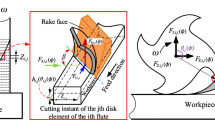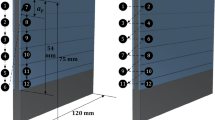Abstract
Simulation based error compensation strategies offer great potential for the milling of thin-walled structures, which is a key process in, for example, the production of structural aerospace components. However, in many industrial applications, complex numerical models or compensation strategies that result in increased machining times, prevent them from being used for process design in a profitable manner. In this article, a numerical approach for the prediction of static surface errors in the peripheral milling of thin-walled structures based on tool and process parameters is presented. The proposed model is designed for the usage within a previously introduced framework that aims towards making virtual compensation strategies more attractive for industrial applications. It is experimentally validated by comparing predicted error profiles with the optically measured finishing surface of thin-walled aluminum plates that were machined with varying process parameters. By using the presented numerical model, the surface error can be accurately predicted, even for small radial cutting depths where the presence of tool runout significantly affects the generation of the surface.








Similar content being viewed by others
References
Wiederkehr P, Siebrecht T (2016) Virtual machining. Procedia Manuf. 6:80–87
Kline WA, DeVor RE, Shareef IA (1982) The prediction of surface accuracy in end milling. J Eng Ind 104(3):272
Budak E, Altintas Y (1995) Modeling and avoidance of static form errors in peripheral milling of plates. Int J Mach Tools Manuf 35(3):459–476
Tsai JS, Liao CL (1999) Finite-element modeling of static surface errors in the peripheral milling of thin-walled workpieces. J Mater Process Technol 94(2–3):235–246
Wan M, Zhang WH, Qui K, Gao T, Yang Y (2005) Numerical prediction of static form errors in peripheral milling of thin-walled workpieces with irregular meshes. J Manuf Sci Eng 117(1):13–22
Wan M, Zhang WH (2006) Efficient algorithms for calculations of static form errors in peripheral milling. J Mater Process Technol 171(1):156–165
Wan M, Zhang WH, Tan G, Qin GH (2008) Systematic simulation procedure of peripheral milling process of thin-walled workpiece. J Mater Process Technol 197(1–3):122–131
Schweinoch M, Joliet R, Kersting P, Zabel A (2015) Heat input modeling and calibration in dry NC-milling processes. Prod Eng Res Devel (Production Engineering) 9(4):495–504
Altintas Y, Kersting P, Biermann D, Budak E, Denkena B, Lazoglu I (2014) Virtual process systems for part machining operations. CIRP Ann Manuf Technol 63(2):585–605
Ratchev S, Nikov S, Moualek I (2004) Material removal simulation of peripheral milling of thin wall low-rigidity structures using FEA. Adv Eng Softw 35(8–9):481–491
Denkena B, Schmidt A, Henjes J, Niederwestberg D, Niebuhr C (2013) Modeling a thermomechanical NC-simulation. Procedia CIRP 8:69–74
Li ZL, Wang XZ, Zhu LM (2016) Arc-surface intersection method to calculate cutter-workpiece engagements for generic cutter in five-axis milling. Comput Aided Design 73:1–10
Ratchev S, Liu S, Huang W, Becker AA (2006) An advanced FEA based force induced error compensation strategy in milling. Int J Mach Tools Manuf 46(5):542–551
Altintas Y, Tuysuz O, Habibi M, Li ZL (2018) Virtual compensation of deflection errors in ball end milling of flexible blades. CIRP Ann 67(1):365–368
Du Z, Zhang D, Hou H, Liang SY (2017) Peripheral milling force induced error compensation using analytical force model and APDL deformation calculation. Int J Adv Manuf Technol 88(9–12):3405–3417
Wimmer S, Zaeh MF (2018) Prediction of surface error characteristics in peripheral milling of thin-walled structures. J Manuf Mater Process 2(1):13
Wimmer S, Ellinger J, Zaeh MF (2018) A cutting force model for finishing processes using helical end mills with significant runout. Prod Eng Res Dev (Production Engineering) 16(5):267
Ratchev S, Liu S, Huang W, Becker AA (2004) A flexible force model for end milling of low-rigidity parts. J Mater Process Technol 153–154:134–138
Author information
Authors and Affiliations
Corresponding author
Additional information
Publisher's Note
Springer Nature remains neutral with regard to jurisdictional claims in published maps and institutional affiliations.
Rights and permissions
About this article
Cite this article
Wimmer, S., Hunyadi, P. & Zaeh, M.F. A numerical approach for the prediction of static surface errors in the peripheral milling of thin-walled structures. Prod. Eng. Res. Devel. 13, 479–488 (2019). https://doi.org/10.1007/s11740-019-00901-7
Received:
Accepted:
Published:
Issue Date:
DOI: https://doi.org/10.1007/s11740-019-00901-7




